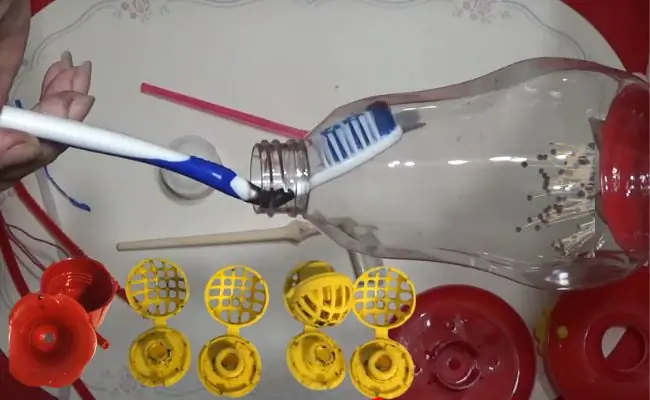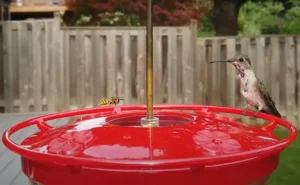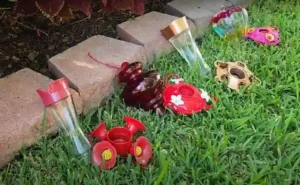Unlock the secrets to an undisturbed harmony between humankind and hummingbirds. Mold, the unseen foe, is a threat to the vitality of the nectar that sustains these tiny miracles.
Explore with us as we are going to find out ways to prevent the stealthy advances of mold and keep hummingbird feeders pristine.
Table of Contents
Mold Causes Hummingbird Feeder Poisonous
Imagine you have a special place in your garden for hummingbirds. These little birds love to sip on sweet nectar from feeders. But here’s the thing, sometimes, a sneaky thing called mold can try to make the hummingbirds’ treat not so tasty or healthy.
As someone who loves watching hummingbirds fluttering in my backyard. The enchanting presence of hummingbirds became a daily source of joy until I realized that maintaining their feeders is more than just a task. It’s a commitment to their well-being.
A while back, I noticed a persistent issue with mold creeping into their sweet nectar, threatening to turn their favorite feeding spot into a health hazard. Taking matters into my own hands, I decided to make a few changes. First and foremost, I established a weekly cleaning routine. Every Sunday morning became feeder spa day.
Taking warm, soapy water, I carefully disassembled the feeder, making sure to reach all the nooks and crannies where mold could hide. The process became a mindful ritual, a moment of connection with nature as I safeguarded the hummingbirds’ sanctuary.
Then mixing a bit of white vinegar with water proved to be a magical potion against mold. Not only did it clean the feeder effectively, but it also left behind a faint scent that seemed to deter other intruders.
Finding the perfect spot for the feeder was another lesson learned through trial and error. I relocated the feeder to a shaded area. It was like giving the hummingbirds their very own cool oasis, free from the threat of mold.
The nectar in the dirty feeder can become a home for potentially lethal mold and fungus. This can sicken and even kill the hummingbirds. If you see a cloudy or milky nectar with visible dark specks, discard that immediately.
Mold can infect the hummingbird’s tongue and cause a condition known as Hummers Candidiasis which can lead to the bird’s death. Moreover, a mother hummingbird can infect her babies after visiting a dirty feeder.
It is a common problem in hummingbird feeders and can be caused by using anything other than white sugar, such as honey, which can cause fungus to develop. Mold can also develop if the feeder is consistently dirty and not cleaned regularly.
Factors causing mold production
There are some factors contributing to mold growth in hummingbird feeders:
- The sugary solution that is used as nectar in the feeders is the primary factor that contributes to mold growth in hummingbird feeders.
- The second factor that usually causes mold to grow in the hummingbird feeder is the temperature, actually the warm temperature. During hot weather, the sugar water solution inside feeders can become a breeding ground for mold, particularly if the feeder is exposed to direct sunlight for extended periods.
- Hummingbird feeders often accumulate moisture, either from condensation or spillage and I have observed that in my feeders it always causes mold growth. Even a small amount of moisture can promote mold growth.
- There are a lot of feeder types available in the market now and failure to clean feeders regularly allows mold to accumulate over time. Some feeder designs have nooks and crannies that are harder to clean, making them more prone to mold growth.
- Using a weaker sugar solution may be attractive, but it is not recommended. Hummingbirds require a suitable energy boost, and weaker solutions tend to ferment more quickly, which can increase the chances of mold formation.
But don’t worry, a few minutes of cleaning each week can be their lifesaver. Mold growth is more common in warm weather.
Therefore, regular cleaning and sterilization of hummingbird feeders is essential. By keeping your feeders clean, you’re not just providing a sweet treat for hummingbirds, you’re ensuring their well-being and contributing to a healthy bird community.
Keeping hummingbird feeders clean is of utmost importance to the health of the hummingbirds. There are some strategies that I use for preventing mold in hummingbird feeders. First of all let’s begin by understanding how mold can harm hummingbirds.
Chemical Composition of Mold Can Harm the Hummingbirds
Mold contains a variety of compounds and toxins that may be very toxic, particularly to hummingbirds. Mold’s chemical composition contains very harmful mycotoxins. Here’s how they may impact hummingbirds:
- Respiratory Issues: When hummingbirds inhale mold spores, they get respiratory infections and disorders that may be severe and even cause the death of hummingbirds.
- Digestive Issues: If the hummingbirds are consuming mold-contaminated nectar from your feeders then it may cause digestive problems like as diarrhea, vomiting, and reduced nutrient intake, weakening the birds and decreasing their chances of survival.
- Liver Damage: Mold also contains certain mycotoxins, such as aflatoxins, that may induce liver damage in hummingbirds, compromising their general health and possibly leading to liver failure.
- Immune Suppression: Exposure to mold may weaken the immune system of hummingbirds, making them more vulnerable to infections and diseases.
- Behavioral Changes: The toxic effects from mold may cause changes in the behavior of hummingbirds, such as lethargy and decreased feeding activity, affecting their energy levels and survival, especially during critical times like migration or breeding seasons.
Mold Prevention Methods
Seeing healthy hummingbirds at feeders brings me joy. Unfortunately, mold on feeders can pose a serious threat to these tiny birds, but don’t worry I am here to help you. You just have to follow these simple methods to prevent the growth of molds.
Regular Cleaning of Feeder
The first and foremost step is to clean hummingbird feeders regularly and when I say regularly, it doesn’t mean to clean feeders every hour. You must set a cleaning frequency and I prefer to clean my feeders according to the weather and usage.
- Hot Weather (above 75°F): Every 1-2 days.
- Mild Weather (60-75°F): Every 3-4 days.
- Cooler Weather (below 60°F): Once in a week.
- High Usage: Increase cleaning frequency if the nectar depletes quickly.
If you are in a hot climate then I recommend only filling your feeders half because it will prevent nectar from spillage.
You must follow this simple cleaning method for hummingbird feeders. Rinse with hot tap water, not boiling water, avoiding soap as it can leave residue hummingbirds to dislike. For a deeper clean, soak the feeder in a solution of 1 part white vinegar to 4 parts water for 30 minutes, then rinse well.
Use Homemade Nectar
You must also consider using homemade nectar in the feeders instead of any artificial nectar from the market. The proper sugar-to-water ratio for making nectar at home is 1 part white sugar to 4 parts water. Higher concentrations of sugar can promote mold growth and also attract wasps.
It is recommended to use plain white sugar to make the nectar. The sugar and water should be mixed. This nectar mixture is preferred by hummingbirds as it replicates the natural nectar from flowers which is about 35% sugar.
Feeder Placement
When it comes to preventing mold in hummingbird feeders, the placement of the feeder is crucial. I placed my feeders in a shady area that was not directly exposed to the scorching sun in summer. Direct sunlight can cause the nectar to spoil more quickly, leading to mold growth. Sunlight also speeds up the process of mold growth.
I observed that the hummingbirds are attracted to clean and flowing water instead of stagnant water because stagnant water can attract mosquitoes, which can be a nuisance to the hummingbirds and may carry diseases and it can also lead to algae growth, which can contaminate the nectar and harm the hummingbirds.
Choose the Right Feeder Type
As I mentioned earlier some feeder designs are easier to clean than others. So, to prevent mold growth in hummingbird feeders, it’s important to choose a feeder type that is easy to clean. I always recommend a saucer-style feeder, since it is the easiest to clean, and is the most bee-proof feeder.
- Look for feeders with wide openings that allow for easy access for cleaning.
- Consider feeders that can be fully disassembled, making it easier to reach all the nooks and crannies where mold can develop.
- Avoid feeders with intricate designs or narrow openings that are difficult to clean thoroughly.
- Refill Your Feeders Regularly
It’s a must for me to refill the feeders every time I clean them. Hummingbirds love to have fresh nectar. Clean your feeders well each time you refill them to help prevent mold and mildew. Boil your syrup and allow it to cool well if you make your own.
Pro-Tips
- Dishwasher-Safe Feeders: You can opt for dishwasher-safe hummingbird feeders. Those are the only ones I use. I also avoid any feeders that are not easy to clean from crannies. Sometimes I clean the hummingbird feeders by putting them in the top basket of the dishwasher. Then I let the dishwasher run its normal cleaning cycle, but I don’t use the drying heat cycle for the feeders.
- Boiling Water For Cleaning: You can also put the feeder in the boiling water to clean but this method may damage plastic feeders or melt parts. It is only effective for the feeders that has metal parts. Never the entire feeder into the boiled water. Disassemble it and only put in the boil water the parts that can withstand high temperatures.
- Red Dye: Avoid any hummingbird nectar containing red dye. It’s harmful to hummingbirds and can make it difficult to detect mold growth. Stick to plain white sugar and water to attract these beautiful birds safely.
- Artificial Sweeteners: Never use artificial sweeteners in hummingbird nectar. These are toxic to hummingbirds and can have adverse health effects.
Hummingbird Feeder Cleaning Techniques
Maintaining clean feeders attracts healthy birds and reduces disease risks.
Clean With Soap, Water, And Vinegar
- Mix 1 part white vinegar with 9 parts warm water in a large container.
- Submerge the feeder completely and soak it for 30 minutes.
- Use a dish brush or soft scrub brush to remove stubborn dirt.
- Rinse thoroughly with clean water.
- For extra disinfection, add 1 tablespoon of bleach solution (1 part bleach to 10 parts water) to the rinse water. Never mix bleach and vinegar directly! (Why???)
- Air dry completely before refilling.
Dishwasher To Clean Feeders
- Check the feeder’s label for dishwasher safety. Plastic feeders are more likely to be dishwasher-safe.
- Remove all parts and place them on the top rack only.
- Run a hot water cycle with dish soap.
- Air dry completely before refilling.
Clean Metal Feeders With Boiling Water
- Bring a large pot of water to a rolling boil.
- Carefully submerge the metal feeder parts for 1-2 minutes.
- Use tongs to remove and let cool slightly.
- Scrub with a brush and rinse thoroughly with clean water.
- Air dry completely before refilling.
Steam Cleaner
- Use a handheld steam cleaner to blast away dirt and grime on metal or plastic feeders.
- Be careful not to damage delicate parts.
- Wipe clean with a damp cloth and air dry completely.
Tips For Using Cleaning Tools
- Bottle Brushes: Choose a bottle brush with soft bristles and a long handle to reach the bottom of narrow-necked bottles effectively. Rinse the brush thoroughly after each use to prevent the transfer of mold or bacteria.
- Pipe Cleaners: Pipe cleaners are excellent for cleaning small feeding ports or intricate feeder designs. Bend the pipe cleaner into different shapes to access hard-to-reach areas.
- Toothbrush: A soft-bristled toothbrush can be repurposed for cleaning feeder components with intricate details or tight spaces. Use gentle, circular motions to avoid scratching the surfaces.
Maintaining a Mold-Free Feeder For a Long Time
Maintaining a mold-free feeder for the long term is crucial for the health and well-being of hummingbirds. Implementing long-term strategies and choosing the right feeder materials can significantly reduce mold problems.
- I believe that Regular cleaning of the hummer feeders is the cornerstone that prevents mold. Aim to clean your feeders frequently you can also follow the frequency mentioned above in this guide.
- Thoroughly disassemble the feeder and scrub all parts with hot, soapy water. Rinse well and allow to air dry completely before refilling. Disinfecting with a diluted vinegar solution (1 part vinegar to 9 parts water) is optional but can be beneficial.
- The location of the feeder also matters. Place feeders in well-ventilated areas with good air circulation and sunlight exposure. Avoid placing them under dense foliage or near damp corners where moisture accumulates.
- I usually replace the nectar every 2-3 days or sooner if it appears cloudy or discolored. This prevents fermentation, which attracts mold.
- I have multiple feeders in my backyard and I rotate them weekly. This allows each feeder to dry completely before being reused.
- I occasionally boil all feeder parts (except for plastic components) for 5 minutes to Kill mold in the hummingbird feeder.
- The most effective strategy that I follow is emptying the feeders at night. This discourages insects and reduces the risk of mold growth overnight.
- I regularly inspect my hummer feeders for signs of mold, such as discoloration, cloudiness, or a slimy film. Address any issues promptly.
I usually use bleach to clean my hummingbird feeders. There’s a myth that using bleach to clean hummingbird feeders can hurt the birds. But that’s not true! If you rinse the feeder well after cleaning, just like you do with your dishes, any tiny bit of bleach left will be harmless. It mixes with the sugar in the feeder water, which makes it safe for the birds. So, don’t worry, using bleach to clean your feeders is fine!
Conclusion
The health of hummingbirds is directly impacted by the cleanliness of their feeders. Mold and fungus in dirty feeders can be deadly for these delicate birds. Regular cleaning of hummingbird feeders is essential to prevent mold growth and ensure the well-being of these tiny creatures.
Do remember, even a small amount of mold can harm hummingbirds So, do not compromise in this matter. If we have bird feeders in our backyards then it’s our responsibility to take care of the hummingbirds. By following these steps, you can ensure their well-being and continue to enjoy their vibrant presence in your backyard.
Help us spread the word and share this guide with fellow hummingbird enthusiasts!
Have questions or personal experiences to share? Leave a comment below! Let’s create a vibrant online community dedicated to caring for these feathered friends.
FAQs
Does Honey Cause Fungus In Hummingbirds?
No honey should ever be put in a hummingbird feeder! A fungus infection on the tongue that is caused by honey can be deadly. As often as every four or five days, change the solution and wash the tube well with hot water each time. Rinse well so there is no soap left behind, and only use soap when you need to.
Why Does Sugar Water Get Moldy?
Sugar is a simple carbohydrate and that’s Mold’s favorite food. Sugar water can get moldy due to the presence of airborne spores, bacteria, and yeast that can contaminate the solution. Mold thrives in moist environments, and sugar water provides an ideal medium for mold growth, especially when exposed to warmth and sunlight.
Why Is My Hummingbird Food Turning Black?
In just a few days, the summer sun can turn the sugar water in your hummingbird feeders into a bacterial soup. This can happen even faster if the feeder is in direct sunlight all day. When it’s extremely hot outside, mold can grow quickly in your feeders.




